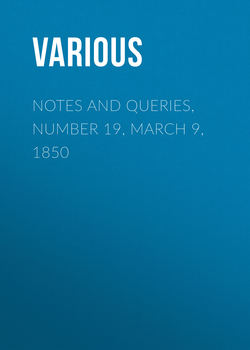Читать книгу Notes and Queries, Number 19, March 9, 1850 - Various - Страница 6
NOTES
FOLK LORE OF WALES
ОглавлениеNo. 1. Cron Annwn.—When a storm sounds over the mountains, the Welsh peasant will tell you that his ear discerns the howl of the Cron Annwn mingling with that of the wind, yet as clearly distinct from it as is the atmosphere in a diving-bell from that of the surrounding waters. These dogs of Annwn, or "couriers of the air," are spirit hounds, who hunt the souls of the dead; or, as occasionally said, they foretell, by their expectant cries, the approaching death of some man of evil deeds. Few have ever pretended to see them; for few, we presume, would linger until they dawned on the sight; but they are described by Taliesin, and in the Mabinogion, as being of a clear shining white, with red ears; colouring which confirms the author of the Mythology of the Ancient Druids in the idea that these dogs were "a mystical transformation of the Druids with their white robes and red tiaras." Popular superstition, however, which must always attribute ugliness to an object of fear, deems that they are either jet black, with eyes and teeth of fire, or of a deep red, and dripping all over with gore. "The nearer," says the Rev. Edmund Jones, "they are to a man, the less their voice is, and the farther the louder, sometimes swelling like the voice of a great hound, or a blood-hound."
They are sometimes accompanied by a female fiend, called Malt y nos—Mathilda or Malen of the night, a somewhat ubiquitous character, with whom we meet under a complication of names and forms.
Jones of Brecon, who tells us that the cry of the Cron Annwn is as familiar to the inhabitants of Ystrad Fellte and Pont Neath-vaughan [in Glamorganshire] as the watchman's rattle in the purlieus of Covent Garden—for he lived in the days when watchmen and their rattles were yet among the things of this world—considers that to these dogs, and not to a Greek myth, may be referred the hounds, Fury, Silver, Tyrant, &c., with which Prospero hunts his enemies "soundly," in the Tempest. And they must recall to the minds of our readers the wisk, wisked, or Yesk hounds of Devon, which are described in the Athenæum for March 27. 1847, as well as the Maisne Hellequin of Normandy and Bretagne.
There has been much discussion respecting the signification of the word Annwn, which has been increased by the very frequent mistake of writing it Anwn, which means, unknown, strange, and is applied to the people who dwell in the antipodes of the speaker; while Annwn is an adaptation of annwfn, a bottomless or immeasurable pit, voidless space, and also Hell. Thus we find, that when Pwyl, or Reason, drives these dogs off their track, the owner comes up, and, reproving him, declares that he is a crowned king, lord of Annwn and Pendaran, i.e. chief of thunder. (See Myth. Ant. Druids, p. 418.)
This Prince of Darkness is supposed to be the spouse of Andraste, now corrupted into Andras, and equivalent with Malt y nos, the Diana or Hecate of the ancient Britons.
These dogs sometimes appear singly, on which occasions they sit by the side of a stream, howling in so unearthly a manner, that the hapless man who finds one in his path usually loses his senses. This seems to have a connection with the "Manthe Doog" of the Isle of Man; but the tradition is not, we suspect, genuine.
Seleucus.
No. 2. Cyoeraeth or Gwrach-y-rhybin.—Another instance of the grand, though gloomy superstitions of the Cymry, is that of the Cyoeraeth, or hag of the mist, an awful being who is supposed to reside in the mountain fog, through which her supernatural shriek is frequently heard. She is believed to be the very personification of ugliness, with torn and dishevelled hair, long black teeth, lank and withered arms and claws, and a most cadaverous appearance; to this some add, wings of a leathery and bat-like substance.
The name Cy-oer-aeth, the last two syllables of which signify cold-grief, is most descriptive of the sad wail which she utters, and which will, it is said, literally freeze the veins of those who hear it; she is rarely seen, but is heard at a cross-road, or beside a stream—in the latter case she splashes the water with her hands—uttering her lamentation, as if in allusion to the relatives of those about to die. Thus, if a man hears her cry fy nqwsaig, fy nqwsaig, &c., his wife will surely die, and he will be heard to mourn in the same strain ere long; and so on with other cases. The cadence of this cry can never be properly caught by any one who has not heard, if not a Cyoeraeth, at least a native of Wales, repeat the strain. When merely an inarticulate scream is heard, it is probable that the hearer himself is the one whose death is fore-mourned.
Sometimes she is supposed to come like the Irish banshee, in a dark mist, to the windows of those who have been long ill; when flapping her wings against the pane, she repeats their names with the same prolonged emphasis; and then it is thought that they must die.
It is this hag who forms the torrent beds which seam the mountain side; for she gathers great stones in her cloak to make her ballast, when she flies upon the storm; and when about to retire to her mountain cave, she lets them drop progressively as she moves onwards, when they fall with such an unearthly weight that they lay open the rocky sides of the mountain.
